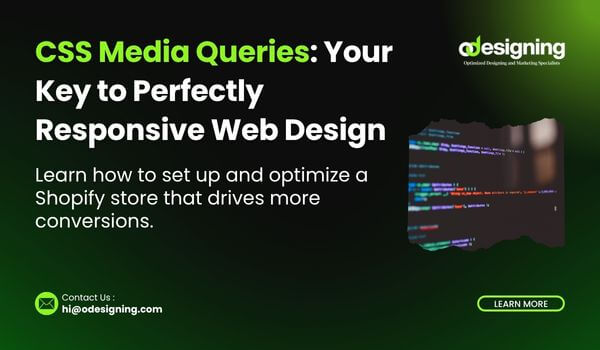Blog
Unlock the Power of CSS Media Queries: The Smart Way to Master Responsive Design

Mastering CSS Media Queries: The Ultimate Guide to Building Truly Responsive Websites
Creating websites that look great across all devices is no longer optional—it’s essential. Whether your visitors use a smartphone, tablet, laptop, or a high-resolution desktop, their experience must remain seamless, fast, and intuitive.
That’s where CSS Media Queries come in. They allow developers to build responsive websites that adapt to the user’s screen size, orientation, and preferences, delivering a consistent experience no matter the device.
Simply put: CSS Media Queries empower your design to respond to its environment.
👉 Also Read: How Flexbox Makes Responsive Layouts Easy (Internal Link)
✅ What Are CSS Media Queries?
CSS Media Queries are part of the CSS3 specification that allow developers to apply CSS styles conditionally based on the characteristics of the device rendering the content. These conditions may include:
-
Viewport width or height
-
Device resolution (in DPI or DPPX)
-
Orientation (portrait vs. landscape)
-
Color scheme preference (dark mode or light mode)
-
Pointer capabilities (coarse touch input vs. fine mouse control)
With media queries, you’re essentially saying:
“If the screen width is 768px or smaller, change the layout and adjust the font size for better readability.”
Example:
This rule targets screens that are 768 pixels wide or narrower, commonly mobile and small tablet devices.
🎯 Why Use Media Queries?
Media queries solve multiple pain points when it comes to multi-device design. Here’s how they benefit your site:
📱 Optimize Layouts
Adjust content layout for different screen sizes—stacking columns on mobile, expanding them on desktops.
👁️ Improve Readability
Increase font size or adjust padding to enhance readability on small screens.
⚡ Boost Performance
Avoid loading or showing unnecessary content or styles on smaller, low-powered devices.
🧑💻 Improve Accessibility
Make the user interface more accessible by respecting user preferences like contrast and color schemes.
📉 Reduce Bounce Rates
A smoother mobile experience leads to better engagement and lower bounce rates.
🧪 Real Examples of CSS Media Queries
Let’s walk through some real-world examples that showcase the power of media queries:
1. Background Change on Mobile Devices
2. Adjust Layout for Landscape Tablets
3. Hide Element While Printing
4. High-Resolution Screens
5. Dark Mode Preference
📏 Common Media Query Breakpoints
There’s no one-size-fits-all set of breakpoints, but these are widely accepted:
| Device Type | Breakpoint Range |
|---|---|
| Small Mobile | 320px – 480px |
| Tablets | 481px – 768px |
| Small Laptops | 769px – 1024px |
| Desktops | 1025px – 1200px |
| Large Screens | 1201px and above |
Tip: Always use min-width for a mobile-first approach, which ensures styles progressively enhance as the screen size increases.
💡 Best Practices for CSS Media Queries
Here are some expert-recommended practices to get the most out of your media queries:
✅ Use min-width
Start with mobile styles and add breakpoints as the screen size grows. This ensures smaller devices don’t have to override desktop styles.
✅ Combine Conditions
Use logical operators like and, or, and not to refine your queries.
✅ Group Queries Logically
Avoid scattered breakpoints. Group similar rules together to keep your CSS organized.
✅ Use Relative Units
Use em, rem, %, or vw instead of fixed px values for better scalability.
✅ Test Thoroughly
Use Chrome DevTools or Firefox Responsive Design Mode to simulate various devices and test breakpoints.
🧠 Advanced Tip: Media Query Ranges
You can define ranges for more targeted styling:
This applies only to screens between 768px and 1024px—perfect for tablets.
📚 External Learning Resources (DoFollow)
❓ Frequently Asked Interview Questions
Q1: What is a media query in CSS?
A feature of CSS3 that allows developers to apply CSS rules based on screen or device properties.
Q2: What’s the difference between min-width and max-width?
-
min-widthapplies styles from that width and above. -
max-widthapplies styles up to that width.
Q3: Can media queries improve performance?
Yes. They help reduce the need to load styles or assets that aren’t relevant to a device.
Q4: Can media queries be used for print layouts?
Absolutely. Use @media print {} to define styles specific to printed versions.
Q5: Can you target dark mode with CSS?
Yes. Use prefers-color-scheme to detect user preference.
⚖ Media Queries vs. Flexbox vs. JavaScript
| Feature | Media Queries | Flexbox/Grid | JavaScript |
|---|---|---|---|
| Responsiveness | Device-based styling | Layout organization | Dynamic runtime logic |
| When Applied | At render time | During layout process | After page load |
| Best For | Breakpoint control | Content flow | Interactive adjustments |
🔚 Final Thoughts
If you want your website to be future-proof, CSS Media Queries are non-negotiable. They let you tailor your website to any screen or device, ensuring usability, performance, and accessibility.
Whether you’re a freelance developer, a designer, or part of a large team, understanding media queries will immediately improve the quality of your user experience.
👉 Next Up: How to Build Responsive Menus with Only CSS (Internal Link)

